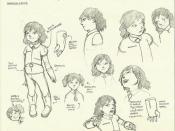In Hawthorne's "The Birthmark," Georgiana's birthmark bears the shape of a hand, but the "hand" refers to much more than a physical description. Alluding to the mark as a work of God, Hawthorne implies God created this flaw as a portrayal of the predestined sin. Although Georgiana appears perfect, she lives the life of a mortal, therefore she must carry the burden of Original Sin. Aylmer blames Nature for this "fatal flaw of humanity" and attempts to rid Georgiana of this imperfection through scientific methods (Hawthorne 12). But as Hawthorne illustrates in his short story, no mortal can improve upon God's creations.
When his experiment proves successful, Aylmer rejoices over his wife's flawlessness, but he soon realizes the consequences of his actions. By achieving perfection, Georgiana defies mortality and dies shortly thereafter. She states, "Do not repent that with so high and pure a feeling, you have rejected the best the earth could offer.
Aylmer, dearest Aylmer, I am dying!" (Hawthorne 21). While Aylmer views the birthmark as a stain marring his wife's face, his wife and even her former lovers recognize it as what essentially defines her existence. Similarly, society functions on the basis of its flaws. As Georgiana cannot attain perfection, society cannot achieve utopia. Thus, Hawthorne illustrates how individuals should accept their shortcomings, rather than try to conceal or remove them.
Because Aylmer tries to perfect God's work, he ultimately proves unsuccessful. Georgiana's birthmark symbolizes the Original Sin bestowed upon all by the "hand" of God. Thus, the birthmark represents the imprint of God's hand itself. As a mere mortal, Aylmer cannot rid his wife of this "crimson hand," for God's strength and powers far surpass the abilities of Aylmer.


